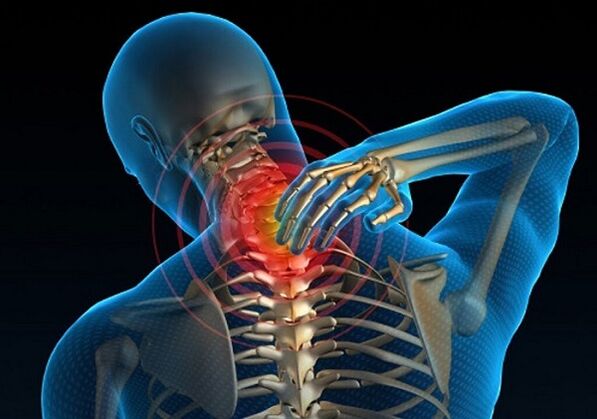
Osteochondrosis is a common disease of the spine, characterized by degenerative changes in the structure of the cartilaginous tissue of the discs and bone base.The pathology mainly manifests itself after 30 years.
Symptoms of cervical osteochondrosis can be different, which greatly complicates the process of diagnosis and subsequent treatment.
Characteristics of the disease
The cervical region is made up of vertebrae and nerve endings.Osteochondrosis of this area is formed during degeneration of the intervertebral nucleus.In this case, the ongoing pathology affects important nerve endings and blood vessels.
The disease is well disguised as other disorders, since the symptoms of osteochondrosis are characterized by attacks of headaches, as well as the appearance of significant discomfort in the neck area.Patients complain of blood pressure problems and nausea.Many people often confuse these symptoms with diseases of the heart and blood vessels.

Often, against the background of persistent problems, the patient begins to suddenly lose consciousness, there is a lack of air and numbness of the tongue.The disease is mainly diagnosed in people over 30 years old, which is associated with constant dynamic and static loads.Recently, such disorders have been observed even among adolescents.
Degrees of development
Symptoms and treatment of cervical osteochondrosis largely depend on the degree of development of the disease.Initially, the nutrition of the cartilage tissue is disrupted, leading to the production of certain enzymes that have a destructive effect.The person feels significant discomfort.Daily morning exercises will help eliminate these symptoms.
At the second stage, the harmful effects of pathological enzymes constantly increase and inflammation begins to develop in the body.Cartilage tissue gradually wears away, causing the vertebrae to begin to touch each other, pinching the nerve endings.Painful sensations become more pronounced.It becomes very difficult for a person to work.
At the third degree, neoplasms and growths on bone tissue begin to form.Symptoms of cervical osteochondrosis in this case manifest themselves in the form of severe pain.There is a metabolic disorder, so salts begin to be deposited on the spine, in the area of inflammation.The process of ossification of the vertebrae begins, which leads to the gradual development of an intervertebral hernia.
It is not always possible to immediately determine the stage of the disease based on the existing symptoms of cervical osteochondrosis, since the degree of tissue destruction may not correspond to the existing signs.
Causes
Before determining the symptoms and treatment of cervical osteochondrosis, you need to understand exactly what factors influence the formation of the pathological process.The development of the disease is influenced by pathological and physiological processes, which are closely related and are mainly considered together.
Physiological changes can be caused by irreversible age-related processes in cartilage tissue.Discomfort occurs when nerve endings are irritated.Pathological changes result from poor diet and a sedentary lifestyle.These disorders mainly occur in adolescents and middle-aged people.

In some cases, osteochondrosis can disappear on its own or manifest itself in the form of short-term disorders.Among the main provoking factors, the following should be highlighted:
- lack of regular physical activity;
- excess weight;
- frequent stay in an uncomfortable position;
- incorrectly selected pillow or mattress;
- nervous overwork;
- hypothermia;
- injuries to the back of the head and neck.
The cause of the development of osteochondrosis can be congenital anomalies, as well as various types of autoimmune diseases.
Main symptoms
There are many vessels and nerve endings located in the neck region.It is for this reason that the symptoms of osteochondrosis of the cervical and thoracic spine are associated with ischemia of certain areas of the brain.In addition, the nerve endings that provide motor activity and sensitivity of the shoulder girdle and upper extremities, when compressed by destroyed vertebrae, can cause various manifestations.Symptoms and treatment of cervical osteochondrosis largely depend on which system is affected by the pathological process.In particular, the following signs can be identified:
- disruption of blood microcirculation due to compression of the vertebral arteries;
- signs of damage to nerve endings;
- severe neurotic pathologies in advanced cases.
The first symptom of cervicothoracic osteochondrosis of the spine is the presence of pain in the neck, back of the head and collar.The location of the pain may be more widespread, causing severe migraines.The nature of the pain largely depends on the location of the lesion and the severity of the pathology.In the early stages of the disease, the discomfort may quickly disappear and the pain gradually becomes chronic and painful.During the period of exacerbation, the pain becomes throbbing, the tone of the neck muscles increases and there is a restriction of head movements.

Among the symptoms of cervical osteochondrosis in women and men are the presence of ringing and noise in the ears, as well as congestion.In some cases, hearing loss occurs.All these manifestations are associated with a decrease in blood flow.
Also among the main features are:
- dizziness,
- pressure changes,
- lack of air,
- nausea,
- visual impairment.
Dizziness is considered one of the symptoms of cervicothoracic osteochondrosis.They are caused by a violation of blood flow to the organs that provide balance in the body.Lack of air can occur as a result of irritation of the nerve endings involved in the regulation of the respiratory process.Patients often complain of not being able to breathe deeply.In some cases, symptoms worsen to severe shortness of breath or asthma attacks.
Lack of oxygen associated with breathing problems is the main cause of increased fatigue, decreased attention and memory problems.In some cases, nausea may occur, caused by poor circulation to certain areas of the brain.Sometimes this can be accompanied by vomiting, loss of appetite and weight loss.
Symptoms of osteochondrosis of the cervical spine are manifested in the form of deterioration in visual acuity.However, such a violation occurs quite rarely.It should be noted that performing therapeutic exercises and wearing glasses do not give the desired result, and vision improves only after treatment for osteochondrosis.
Unstable pressure is caused by impaired blood circulation in the area of the brain responsible for the functioning of the vasculomotor center.In some cases, a slight increase in temperature and local redness of the skin may be observed.
It is very important to quickly recognize the symptoms of cervical osteochondrosis.The feeling of discomfort and pain does not always occur, which is why it is important to conduct a timely comprehensive examination and competent treatment.It should be noted that each patient feels a characteristic crunch and clicks when moving the neck, and it is by this sign that one can recognize the course of the pathology.
Carrying out diagnostics
If symptoms of cervical osteochondrosis appear, treatment should be started immediately, which is why it is advisable to immediately consult a neurologist.To establish the cause of existing symptoms, a comprehensive examination is necessary.
During an examination with neurological tests, the doctor assesses the degree of mobility and pain in the neck area, as well as the characteristics of blood circulation in the vertebral artery.Among the main diagnostic methods, it is worth highlighting:
- x-ray of the cervical vertebrae,
- discography,
- tomography,
- myelography,
- Doppler ultrasound.
All this will allow us to determine the location of the lesion and the degree of advanced disease, as well as select the most effective treatment regimen.The treatment process is quite long and requires patience.

It is impossible to completely restore cartilage structures, but it is possible to significantly improve the quality of life and get rid of chronic pain.It is very important to monitor the progress of the disease in order to adjust the treatment program if necessary and to predict possible improvements or complications.
Treatment characteristics
Regardless of the symptoms, treatment of cervical osteochondrosis is carried out using conservative methods and it is always comprehensive.The use of medications is required, including:
- anti-inflammatory drugs,
- painkillers,
- corticosteroids,
- muscle relaxers,
- vitamin complexes.
In severe cases, novocaine blockades are prescribed in the most painful area.Sometimes the introduction of hormonal agents may be indicated.Additionally, local treatment is indicated, which involves the use of warming ointments and gels.Physiotherapy and exercise therapy have a good effect.Such techniques can strengthen your neck muscles very quickly and effectively.However, their use is possible only after the end of the acute period.

To increase the space between the vertebrae, hardware spinal traction is indicated.In severe cases, surgical intervention is necessary, but there must be appropriate indications for this.
The therapy can be supplemented by wearing a Shants orthopedic collar.Thanks to the strong fixation of the cervical vertebrae, the treatment is carried out much faster.This device allows you to quickly cope with painful sensations, normalize blood circulation in the neck and improve the general well-being of the patient.
Drug therapy
Depending on the symptoms of cervicothoracic osteochondrosis, drug treatment is selected individually.Therapy aims to eliminate pain, inflammation, as well as restore normal mobility of the vertebrae and blood circulation.
Among the main groups of drugs, the following should be highlighted:
- painkillers;
- anti-inflammatory;
- chondroprotectors;
- muscle relaxers;
- vitamin complexes.
You need products for external use, which can be used in the form of ointments and gels.They help to normalize blood circulation, eliminate pain and spasms, and also produce a warming effect.

Treatment with drugs that normalize cerebral circulation will help eliminate the symptoms of cervical osteochondrosis of the spine.To improve metabolic processes in the brain and restore thinking and memory, nootropic drugs are needed.
Physiotherapeutic techniques
Treatment with special therapeutic exercises will quickly and effectively help eliminate the existing symptoms of cervical osteochondrosis at home.In addition to exercise therapy and the use of medications, the range of measures includes the following methods of influence:
- stretching the spine,
- massage,
- physiotherapeutic influence.
Spinal traction will increase the spaces between the vertebrae.However, it is worth remembering that the load must be dosed.The impact is carried out in different ways, including using special tables.
The massage gives very good results.This procedure normalizes blood circulation, nutrition and gas exchange of cartilage tissue.In addition, with the help of massage you can eliminate muscle tension and spasms and get rid of painful sensations.

Physiotherapeutic effects involve the use of various means, such as:
- laser exposure,
- magnetic field,
- ultrasound,
- low frequency current.
In some cases, medications are also used in combination with physiotherapy, which increases their effectiveness and avoids the appearance of side effects.
Acupuncture allows you to improve or slightly slow down the body's processes by influencing biologically active points.The greatest effectiveness of all these measures is achieved when used holistically.
Traditional methods
When the first symptoms of cervical osteochondrosis appear, home treatment involves the use of medicinal baths to quickly eliminate pain and inflammation.In addition, they help relax the spine.Water procedures should be carried out every other day, and the duration of treatment includes 15-20 procedures.
You can add a decoction of mint, chamomile, birch, lemon balm or sage to your bath water.Yarrow infusion is well suited for oral administration, as it helps to quickly eliminate inflammation, pain and spasms.A solution of sea salt can be used as a compress.Home treatment will help quickly eliminate the symptoms of cervical osteochondrosis, but before using any means and techniques, you should definitely consult a doctor to avoid complications.
Carry out prevention
The best means of prevention is a healthy lifestyle, as well as the formation of posture from childhood.For prevention purposes, it is recommended:
- nutritional adjustments;
- use of an orthopedic pillow and mattress for sleeping;
- smooth lifting of weights.
The initial form of the disease usually does not have pronounced symptoms.If you experience aching pain in your sternum, you should seek medical attention immediately.
Possible complications
With timely diagnosis and proper treatment, osteochondrosis of the cervical spine occurs without complications.Otherwise, there is a risk of various types of pathological changes that can lead to disability.Among the main complications are:
- circulatory disorders in the brain;
- increased blood pressure;
- weakness, numbness, muscle atrophy;
- hernias and protrusions;
- vegetative-vascular dystonia;
- neurological disorders.
To avoid the development of complications, you must strictly follow all recommendations of your doctor.Getting rid of unpleasant sensations at an early stage is much easier than treating an advanced disease.It is also important not to forget about prevention and preventing poor posture in children.Folk remedies help to fight the disease, but you should not completely rely on them and refuse drug treatment.This can lead to an exacerbation of the problem when surgery is necessary.













































